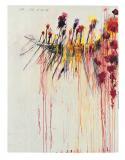Art Of The Day Weekly
#451 - from 1 December 2016 to 7 December 2016

Cy Twombly, Coronation of Sesostris, 2000, Part V : Acrylic, wax crayon and lead pencil on canvas, 206,1 x 156,5 cm. Pinault Collection © Pinault Collection / Photo Robert Mc Keever
Twombly, in praise of scribbling
PARIS - Roland Barthes was one of his greatest admirers, and saw his "hand in levitation" and his "laziness" as what allowed him to "avoid the platitude of graphic codes". The work of Cy Twombly, made in signs, brushed or erased just as on palimpsests, writing that is generally impossible to decipher, enraged scribblings and colour drippings, is now admired and seen by the market and by museums as a major artist of the XXth century. Some of them feel a certain poetry, a spirituality, a mystery derive from them, that can be savoured like a deep emotion, doing quite well without explanations. Others only see it as an incomprehensible glorification of scribblings. The Centre Pompidou, with this retrospective of 140 works by the artist, gives the elements to finalize positions. We also discover a less-known aspect of this Lexington native (1928-2011), who became a major Italian bourgeois through his marriage to a Franchetti heiress: sculpture. These objects that were found, assembled, made into pedestals and covered with modest white paint, are ideally set up against the large glass opening with the Sacré-Cœur in the background. While Twombly was surely very cultivated, and had great knowledge of the past (he had come to Europe, attracted by Lascaux), we have a hard time agreeing with the curator when he presents the artist- in particular with his series on Emperor Commodus - as a renovator of historical painting. In his work, hermetism remains, all along his career, one of the fundamental characteristics. With this artist, like with ancient mysterious religions, it is very important not to understand everything.
• Cy Twombly at the Centre Pompidou, from 30 November 2016 to 30 April 2017.
